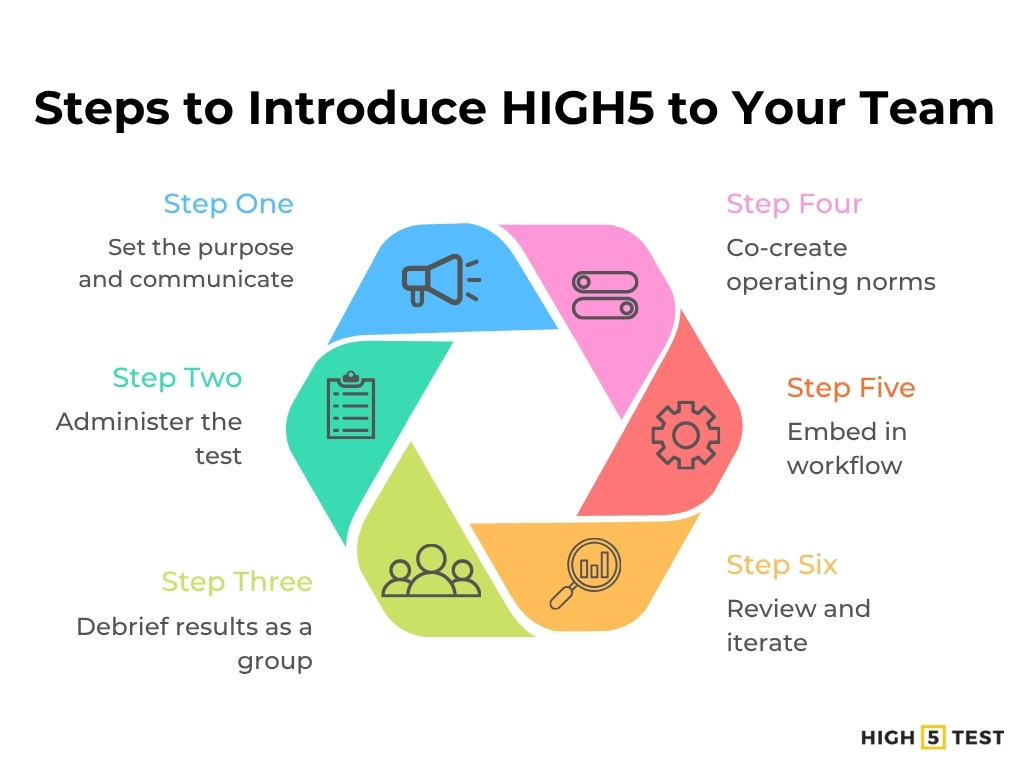Understanding workplace personality is now a strategic priority. In remote, hybrid, and on-site teams, each person works, communicates, and collaborates in their own way. When leaders recognize those differences, they create stronger alignment, reduce friction, and improve results.
In this guide, you’ll learn:
- What “workplace personality” really means
- How personality affects work across different environments
- How to adapt your leadership style to different personalities
- How to use structured tools like HIGH5 to map and use team strengths
- Actionable templates, examples, and a launch plan
Let’s get into it.

How personality shapes workplace behavior
Personality influences how people communicate, handle stress, and remain motivated. In a team, these differences can either support collaboration or create friction. They can:
- Improve or impede communication
- Influence who takes the initiative vs who prefers structure
- Affects how people respond under stress
- Shape what motivates or drains each individual
A leader’s sensitivity to personality isn’t about labeling people, it’s about creating environments and systems where each person can thrive.
Common personality models used at work
Many frameworks help teams understand behavior. Some of the most widely used include:
- Strengths-based or talent frameworks
- Big Five (OCEAN): Openness, Conscientiousness, Extraversion, Agreeableness, Neuroticism
- MBTI / Jungian-based models
- DISC / behavioral-style models
Strengths-based approaches shift the focus toward what people do well and where they feel most engaged. This perspective is often more constructive than models that focus on deficits.
A useful strengths tool is HIGH5, which identifies a person’s top five strengths and provides team-level insights. We’ll explore how to apply it later in the article.
Personality in different work environments
Work environments shape how personality traits manifest on a day-to-day basis. Each setting (onsite, remote, or hybrid) can either support or challenge different behaviors. Leaders who recognize these patterns can reduce friction and improve collaboration.
In on-site/in-person settings
In-person environments tend to favor fast-paced interaction and social energy. People who thrive on verbal exchange and spontaneity often perform well, while others may find the constant engagement draining.
Common strengths:
- Extroversion, spontaneity, relational energy
- Informal communication, sidebar chats, water-cooler interactions
Typical challenges:
- Introverts may feel overstimulated or overlooked
- Meetings can crowd out reflection or independent thought
- Constant interaction can create distractions or pressure to engage
What leaders can do:
- Design quiet zones or set aside time for focused work
- Alternate meeting formats (e.g., smaller groups, walking discussions)
- Mix live interactions with asynchronous updates
In remote settings
Remote work supports autonomy and focus but can also introduce gaps in communication and connection. People who are comfortable working independently may thrive, while others may feel isolated or unsure of expectations.
Common strengths:
- Self-discipline, autonomy, focus, and written communication
- Reflection, asynchronous workflows, deep work
Typical challenges:
- Miscommunication due to a lack of tone or delayed responses
- Ambiguity around expectations or work boundaries
- Feelings of isolation or uneven engagement levels
What leaders can do:
- Set clear norms for response times, documentation, and tone
- Schedule consistent check-ins via video or audio
- Use dashboards and shared tools for visibility
- Create light-touch social spaces (e.g., virtual coffees or small-group chats)
In hybrid settings
Hybrid models combine flexibility with complexity. Some people thrive, but others may feel overlooked based on how often they’re physically present.
Typical challenges:
- Some people may feel favored when in-office days get more weight
- Disparities in presence or access create “in vs out” dynamics
- Personality preferences (who likes remote vs onsite) clash more visibly
What leaders can do:
- Rotate in-office schedules or responsibilities
- Design hybrid meetings with a remote-first mindset
- Use structured facilitation to keep meetings balanced
- Acknowledge and validate different work preferences without making them personal
How to identify personality patterns
Instead of forcing people into fixed “types,” focus on patterns or tendencies. These patterns help guide communication and collaboration without reducing individuals to labels.
Below are a few sample archetypes that illustrate different personality tendencies. Use them as reference points, not boxes.
| Archetype / Persona | Core Traits / Cues | Strengths | Possible Tensions |
| The Energizer / Connector | Outgoing, talkative, enjoys informal interactions | Builds networks, lifts team energy, sparks ideas | May interrupt or shift focus too often, struggles with sustained focus |
| The Reflector / Observer | Quiet, listens more than talks, prefers time to think | Brings thoughtful input, notices gaps, offers insight | May appear disengaged or respond slowly in fast-paced settings |
| The Analyzer / Planner | Organized, detail-focused, seeks structure | Ensures accuracy, manages risks, and delivers consistently | May resist change or find ambiguity uncomfortable |
| The Harmonizer / Diplomat | Relational, empathetic, avoids conflict | Supports team cohesion, reads group dynamics well | May delay decisions or avoid hard conversations |
Each of these patterns can show up differently depending on the context. One person might display strong planning tendencies at work but take a more flexible approach outside of it. Look for repeated cues rather than one-off behaviors.
When working with others, ask yourself:
- What do they seem to prioritize—clarity, speed, relationships, depth?
- How do they respond under pressure?
- Where do they add the most value?
Identifying personality patterns is not about categorizing people. It’s about noticing what helps them work well and where friction might emerge. This awareness enables clearer communication, more realistic expectations, and more thoughtful collaboration.
Adapting your leadership to different personalities
Understanding personality is important. The next step is adjusting your leadership approach to bring out each person’s strengths. Focus on these areas:
Communication and feedback
- Some people respond best to direct comments. Others prefer more measured, thoughtful language.
- While some want immediate input, others need space to reflect before engaging.
- When sharing feedback, structure it clearly: “Here’s what I noticed, what I appreciate, and what I suggest we change.”
Task and responsibility alignment
- Match responsibilities to strengths. Strategic thinkers thrive on open-ended work. Detail-oriented individuals do best with structured, step-by-step tasks.
- Introduce challenges gradually. Occasional stretch assignments help develop new skills without overwhelming.
- Pair people with complementary traits. For instance, match someone action-driven with someone who prefers careful planning.
Handling conflict and tough conversations
- Set clear agendas and ground rules in advance.
- Use structured formats like turn-based discussion or timed speaking to ensure balance.
- Encourage everyone to share how they prefer to approach disagreements. This helps prevent future friction.
Supporting motivation and growth
- Some people are energized by recognition and group interaction. Others are more motivated by independence and personal growth.
- Connect development opportunities to individual strengths. This might mean mentoring, leading projects, or working on focused topics.
- Use regular one-on-ones to revisit goals and adjust based on changing interests or needs.
Making team strengths visible with HIGH5
Personality insights are more powerful when anchored in a shared, structured tool. One tool that works well for teams is HIGH5. Here’s how it fits:
What is HIGH5?
HIGH5 is a strengths-based assessment that identifies each person’s top five energizing traits, what comes naturally, and drives performance. It avoids labeling traits as strengths or weaknesses and instead focuses on what fuels individuals.
Each participant receives a personalized report, while the report for teams gains access to group-level insights. These include “Group Fit” and “Working Together” metrics, which show how individual traits align or conflict within the group.
Key features and benefits
- Emphasizes positive, energizing qualities
- Reveals how team traits interact
- Offers guidance for improving collaboration
- Supports hiring and team-building through “Group Fit”
Some users report that leveraging such strength-based tools leads to higher engagement, clearer alignment, and improved collaboration.
How to introduce HIGH5 to your team
Here’s a simple process for integrating HIGH5 or a similar tool into your workflow:
- Set the purpose and communicate: Share the reason behind the initiative—better teamwork, stronger alignment—and emphasize open, safe discussion.
- Administer the test: Give all team members access to the test and allow time to complete it privately.
- Debrief results as a group: Review individual and team findings together. Explore trends, questions, and areas of surprise.
- Co-create operating norms: Use the insights to shape how the team meets, communicates, resolves conflicts, and divides tasks.
- Embed in workflow: Refer to the results in meetings, retrospectives, project assignments, and feedback discussions.
- Review and iterate: Revisit the insights as your team grows or shifts focus.

You can also compare alternatives (MBTI, DISC, Big Five, etc.) depending on your goals.
Case study: Aligning hybrid teams
Background
Team “Alpha” is a hybrid product development group (some in-office, some remote). This created a disconnect. In-office employees felt more engaged during physical meetings, while remote members struggled with visibility and inclusion.
What they did
1. They used the HIGH5 tool to assess personality traits across the team.
2. Results showed a clear pattern. Remote-first members leaned toward Analyzer and Reflector traits, preferring quiet, focused work. In contrast, those often onsite are identified as Energizers and Connectors, thriving on interaction and spontaneity.
3. During a team debrief, tension surfaced. A remote member shared, “When you’re onsite, the energy is high—but remote days feel neglected.”
4. The team set new norms. They introduced daily check-ins regardless of location, rotated in-office schedules, and restructured meetings to include remote-friendly formats.
5. Sub-teams were reshaped to include a mix of personality types—ensuring each group had both Connectors and Reflectors.
Result (after 3 months)
- Reported higher belonging in remote days
- Reduced friction in task handover
- More consistent productivity with fewer scheduling conflicts
This is a simplified example, but it demonstrates how personality insight, structure, and norms lead to tangible changes.
Toolkit and next steps
- Personality alignment matrix: A tool to map individual strengths and working preferences.
- Meeting norms cheat sheet: Clear guidelines for running effective hybrid sessions.
- Conversation prompts: Use prompts like “When I’m stressed, I prefer…” to encourage open, honest discussion.
- Role assignment worksheet: Match tasks with individual strengths to improve engagement and accountability.
- Launch plan checklist: A step-by-step guide to support assessment rollout.
FAQs
Which workplace personality model is the best?
No single model fits all. Use what aligns with your goals (team cohesion, hiring, leadership development). HIGH5 is strong when you want positive, actionable strengths work.
What is workplace personality?
Workplace personality refers to the unique set of traits, behaviors, and attitudes that shape how a person thinks, communicates, and collaborates at work. It influences how you approach problem-solving, manage stress, build relationships, and contribute to team culture. Unlike general personality, workplace personality is specifically observed in professional settings, such as how you handle feedback, adapt to change, or motivate others.
What is the most difficult person to work with?
The most difficult people to work with are often those who negatively impact collaboration and productivity. While this can vary by team culture, some common challenging workplace personalities include:
- The Micromanager – Struggles to trust others and controls every detail.
- The Chronic Complainer – Focuses on problems without offering solutions.
- The Credit-Taker – Claims others’ work and undermines team morale.
- The Passive-Aggressive Colleague – Avoids direct communication and creates tension.
- The Resistant-to-Change Employee – Rejects new ideas, slowing progress and innovation.
Identifying these behaviors early helps teams set boundaries, improve communication, and resolve conflicts before they escalate. Taking a workplace personality test can also help teams understand differences and prevent personality clashes.
Conclusion
When leaders invest in understanding workplace personality, they gain a multiplier: better communication, stronger alignment, lower friction, and more engaged teams. This becomes especially important as teams operate across remote, hybrid, and onsite setups.
It’s not about putting people into categories; it’s about working with real behavior to lead more clearly and reduce unnecessary conflict. This kind of awareness enables teams to stay connected, adapt quickly, and sustain their performance over time.



